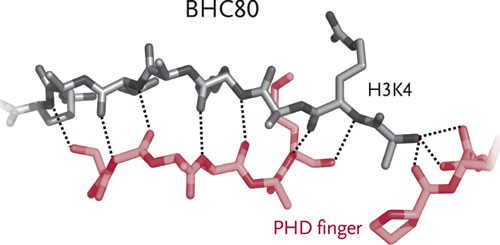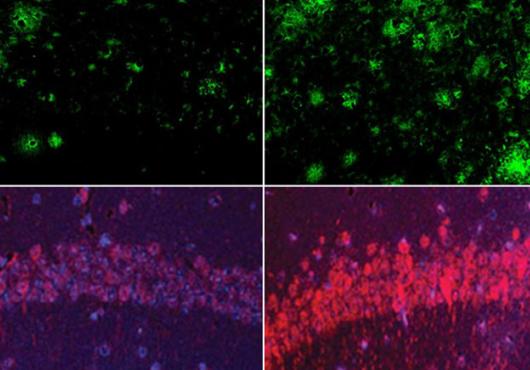Pinpointing the function of a small protein associated with an enzyme that regulates histone modifications on chromatin may illuminate a new symbol in the histone code, a key aspect of the growing field of epigenetics. Now, not only the presence, but also the absence, of chemical groups on histone tails acts as a marker that controls gene expression.
In the Aug. 9 Nature, HMS researchers Yang Shi, professor of pathology, and Fei Lan, research assistant and graduate student in pathology, describe the role of BHC80, a protein component of the histone demethylase LSD1, which regulates chromatin structure and gene activation. Shi and Lan found that BHC80 recognizes the histone H3 lysine 4 (H3K4) only when it has no methylation markers. “This is the first report of a specific protein module that can read an unmodified state in mammals,” said Shi. “People are paying a lot of attention to histone modification, but the unmodified state is as important as the modified state.”
Sweep Away, Keep AwayBHC80 is just one protein piece of the LSD1 enzyme complex, which, as a demethylase, removes mono- and di-methyl groups that are attached to histone H3K4. Histones provide the structural scaffold for DNA to wrap around, forming the “pearls on a string” pattern that makes up chromatin. The state of histones—what chemical groups they do or don’t have attached to them—affect the DNA’s availability for transcription. In this case, when LSD1 removes methyl groups from H3K4, it prevents the associated DNA from being transcribed.
While LSD1 and the other components work to bind and remove chemical groups attached to H3K4, BHC80, equipped with a structure called a PHD finger, binds to the naked histone, something scientists had never before encountered.
The question remains why the LSD1 complex, a demethylase, would need something that recognizes and binds to H3K4 after the enzyme itself has removed the methyl groups. Shi believes that BHC80 may act as a placeholder; while BHC80 binds to the demethylated histone, it keeps the rest of the enzyme complex on a short leash nearby. “We speculate that it wants to keep LSD1 nearby to prevent remethylation. If you have methylase trying to put on a methyl group, the LSD1 can continue to remove it,” said Shi. If the LSD1 complex left the histone, it is possible that the histone could become remethylated and change the chromatin state.
Structure WhysTo establish these features of chromatin behavior, Shi and Lan first ran biochemical experiments analyzing the specific histone modification that the BHC80 PHD finger binds and, surprisingly, discovered it connects to the unmethylated H3K4 tail, which was unlike the other known PHD fingers that act as methyl–lysine binding modules. Given that LSD1 demethylates mono- and di-methylation and results in an unmethylated state on H3K4, the researchers proposed that BHC80 might function to lock LSD1 on its demethylated product. They went on to prove this idea by using an in vitro peptide pull-down assay. Lan and colleagues found that while LSD1’s enzymatic function initially worked without BHC80, it could not stay bound to the histone once it had removed methyl groups. LSD1, however, stayed on the demethylated histone H3 tail in the presence of BHC80.
To better understand these interactions, the researchers collaborated with Robert Collins and Xiaodong Cheng of Emory University to examine a cocrystal structure of BHC80 and its PHD finger bound to a histone. “The structural information really explains the specificity—how and why this module only recognizes H3K4,” said Shi. Finally, the researchers conducted experiments in vivo, looking to see how cells’ genes behaved with different levels of LSD1 and BHC80. When they depleted BHC80 within the cells, genes that are repressed by LSD1 became active, indicating that LSD1 needs BHC80 to block further remethylation by competing enzymes.
While the study describes a minute protein involved in a single interaction, it has larger implications. It provides another piece of the histone code—the markers placed on histones that generate patterns of gene expression and repression—which is still being pieced together. In the Aug. 2 Nature, Bradley Bernstein, HMS assistant professor of pathology at Massachusetts General Hospital, and colleagues generated genomewide chromatin-state maps and reported that certain trimethylated histones marked genes that are expressed, poised for expression, or repressed. Even one or two methyl groups on a histone tail can alter gene expression.

This work indicates a practical technique for using chromatin state as an indicator of a cell’s particular fate. Yet the actual method of how these destiny-determining histone modifications are inherited from parent to daughter cells, and from parent to daughter organisms, is still largely unknown and remains one of the biggest questions in the epigenetics field.
With the discovery of BHC80’s behavior, Shi and Lan have thrown another marker into the histone code: zero methyl groups. And BHC80 may be just the beginning. “We predict that there are many more of those modules yet to be identified that will recognize additional unmodified states of other residues on the tail,” Shi said.


